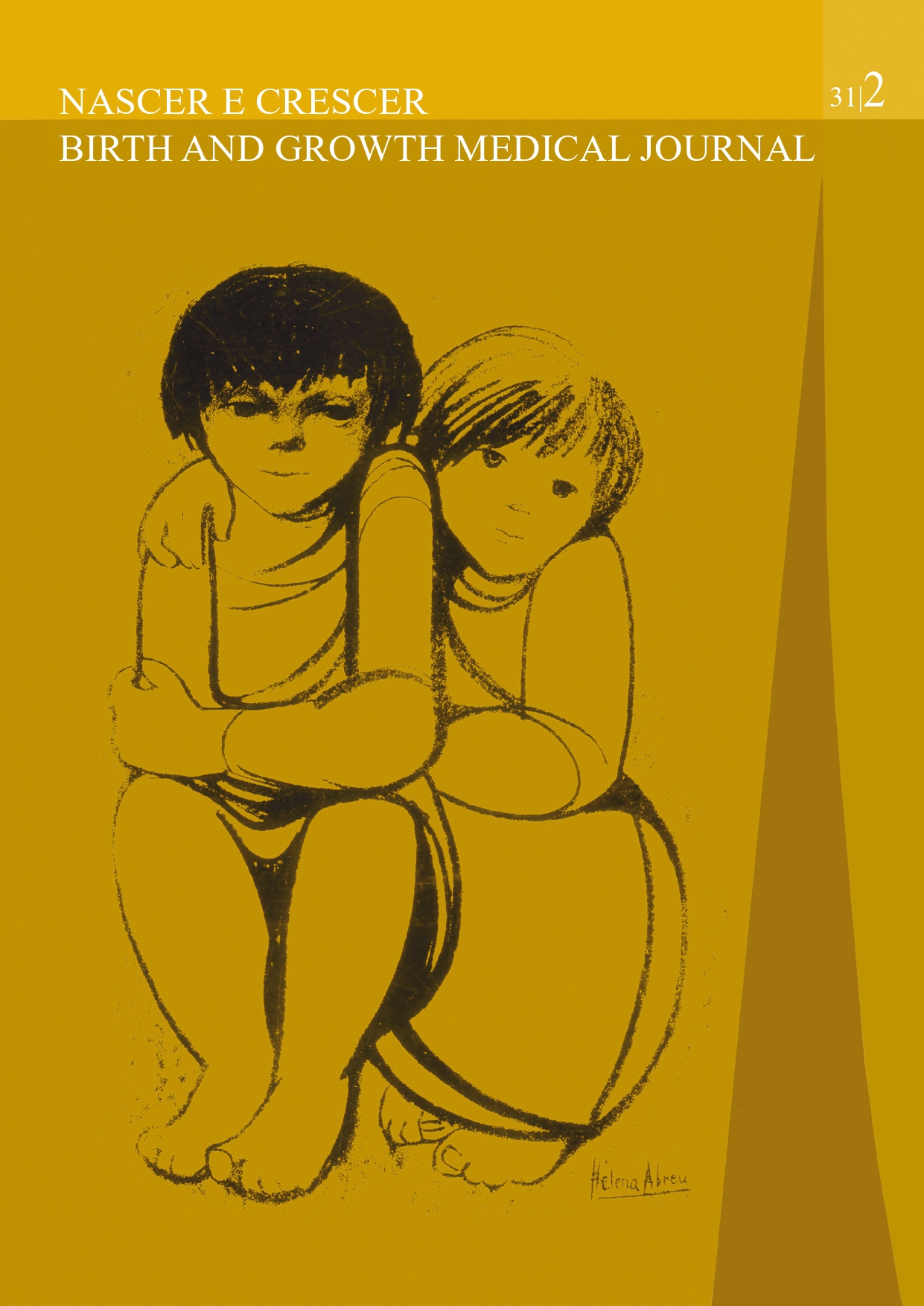Positive blood culture and neonatal sepsis – A five-year study
DOI:
https://doi.org/10.25753/BirthGrowthMJ.v31.i2.23899Keywords:
antimicrobial susceptibility, blood culture, newborn, sepsisAbstract
Introduction: Neonatal sepsis remains a major cause of morbidity and mortality in pediatric age. Since the predominant causative microorganisms vary between regions and over time, it is crucial to know the local epidemiology. The aim of this study was to characterize patients with positive blood culture and clinical presentation of sepsis admitted to a Neonatology Unit and identify possible risk factors and implicated microorganisms and respective antimicrobial susceptibility patterns.
Methods: This was a retrospective descriptive study of clinical data of patients admitted to the Neonatology Unit of a level II hospital with positive blood culture and clinical presentation of sepsis over five years (2014-2018).
Results: Seventy-three culture-proven sepsis cases were identified, 51 (69.9%) of which corresponded to low-birth-weight neonates and 52 (71.2%) to preterm newborns. Most cases (60; 82.2%) concerned late-onset sepsis. The most frequent microorganisms identified were coagulase-negative Staphylococcus (55; 75.3%), mainly associated with late-onset sepsis. Group B Streptococcus and Escherichia coli were the most common microorganisms isolated in early-onset sepsis. No cases of methicillin-resistant Staphylococcus aureus were identified. Coagulase-negative Staphylococcus presented high resistance rates to beta-lactam antibiotics.
Conclusions: The results retrieved from this study document the local epidemiology of neonatal sepsis and show a high frequency of late-onset sepsis associated with nosocomial pathogens. Coagulase-negative Staphylococcus spp. are resistant to the most commonly used antibiotics, with these cases requiring the use of vancomycin. It is crucial to implement effective guidelines to control and prevent nosocomial infections and reduce the incidence, morbidity, and mortality of neonatal sepsis, as well as the need for broad-spectrum antibiotics.
Downloads
References
Adams-Chapman I, Stoll BJ. Neonatal infection and long-term neurodevelopmental outcome in the preterm infant. Curr Opin Infect Dis 2006; 19: 290-7. https://doi.org/10.1097/01.qco.0000224825.57976.87.
Shane AL, Sánchez PJ, Stoll BJ. Neonatal sepsis. Lancet 2017; 390:1770-80. https://doi.org/10.1016/S0140-6736(17)31002-4.
Cortese F, Scicchitano P, Gesualdo M, Filaninno A, De Giorgi E, Schettini F, et al. Early and late infections in newborns: Where do we stand? A review. Pediatr Neonatol. 2016; 57(4):265-73. https://doi.org/10.1016/j.pedneo.2015.09.007.
Centers for Disease Control and Prevention. Prevention of perinatal Group B Streptococcal Disease – revised guidelines from CDC. MMWR 2010;59(No. RR-10):1-36.
Bizzarro MJ, Raskind C, Baltimore RS, Gallagher PG. Seventy-five years of neonatal sepsis at Yale: 1928–2003. Pediatrics 2005;116:595–602. https://doi.org/10.1542/peds.2005-0552.
Pokhrel B, Koirala T, Shah G, Joshi S, Baral P. Bacteriological profile and antibiotic susceptibility of neonatal sepsis in neonatal intensive care unit of a tertiary hospital in Nepal. BMC Pediatr. 2018;18:208. https://doi.org/10.1186/s12887-018-1176-x.
Graça A, Moniz C, Lito L, Salgado MJ, Guerreiro MO. Infecção Neonatal – Importância do Conhecimento da Epidemiologia Local. Acta Pediatr Port 2005;36(6): 267-72. https://doi.org/10.25754/pjp.2005.4906.
Secção de Neonatologia da SPP. Septicémia neonatal – etiologia. Estudo multicêntrico da Secção de Neonatologia da SPP. Acta Pediatr Port 1999;30(4): 299-305. https://doi.org/10.25754/pjp.1999.5488.
Vergnano S, Menson E, Kennea N, Embleton N, Russell AB, Watts T, et al. Neonatal infections in England: the NeonIN surveillance network. Arch Dis Child Fetal Neonatal Ed. 2011;96:9-14. https://doi.org/10.1136/adc.2009.178798.
Stoll BJ, Hansen NI, Sánchez PJ, Faix RG, Poindexter B, Van Meurs KP, et al. Early onset Neonatal Sepsis: The Burden of Group B Streptococcal and E.coli Disease continues. Pediatrics 2011;127: 817-26. https://doi.org/10.1542/peds.2010-2217.
Morioka I, Morikawa S, Miwa A, Minami H, Yoshii K, Kugo M, et al. Culture-Proven Neonatal Sepsis in Japanese Neonatal Care Units in 2006-2008. Neonatology 2012; 102:75-80. https://doi.org/10.1159/000337833.
Maia C, Paúl A, Mesquita J, Santos-Silva I, Negrão F, Faria D. Sépsis Neonatal – análise retrospectiva de 2004 a 2006 da Maternidade Bissaya Barreto. Saúde Infantil. 2010; 32(1):28-32.
Stoll BJ, Hansen N, Fanaroff AA, Wright LL, Carlo WL, Ehrenkranz RA, et al. Late-Onset Sepsis in Very Low Birth weight Neonates: the Experience of the NICHD Neonatal Research Network. Pediatrics 2002;110:285-91. https://doi.org/10.1542/peds.110.2.285.
Dalai R, Dutta S, Pal A, Sundaram V, Jayashree M. Is Lumbar Puncture Avoidable in Low-Risk Neonates with Suspected Sepsis? Am J Perinatol 2020. https://doi.org/10.1055/s-0040-1714397. Online ahead of print.
Aleem S, Greenberg RG. When to Include a Lumbar Puncture in the Evaluation for Neonatal Sepsis. Neoreviews. 2019;20(3):e124-e134. https://doi.org/10.1542/neo.20-3-e124.
Barreirinho MS, Guedes A, Soares P, Braga AC, Oliveira P. Sépsis Neonatal. Acta Pediatr Port. 2000;31:371-6.
Bizzarro MJ, Shabanova V, Baltimore RS, Dembry LM, Ehrenkranz RA, Gallagher PG. Neonatal Sepsis 2004-2013: The Rise and fall of Coagulase-Negative Sthaphylococci . J Pediatr 2015;166:1193-99. https://doi.org/10.1016/j.jpeds.2015.02.009.
Ramasethu J. Prevention of Health Care–Associated Infections in the NICU. NeoReviews 2020; 21(8):e546-e558. https://doi.org/10.1542/neo.21-8-e546.
Downloads
Published
How to Cite
Issue
Section
License
Copyright (c) 2022 Adriana Ferreira, Eulália Sousa, Joaquim Freitas, Mariana Viana, Filipa Miranda, Francisco Pereira da Silva

This work is licensed under a Creative Commons Attribution-NonCommercial 4.0 International License.
Copyright and Authors' Rights
All articles published in Nascer e Crescer - Birth and Growth Medical Journal are Open Access and comply with the requirements of funding agencies or academic institutions. For use by third parties, Nascer e Crescer - Birth and Growth Medical Journal adheres to the terms of the Creative Commons License "Attribution - Non-Commercial Use (CC-BY-NC)".
It is the author's responsibility to obtain permission to reproduce figures, tables, etc. from other publications.
Authors must submit a Conflict of Interest statement and an Authorship Form with the submission of the article. An e-mail will be sent to the corresponding author confirming receipt of the manuscript.
Authors are permitted to make their articles available in repositories at their home institutions, provided that they always indicate where the articles were published and adhere to the terms of the Creative Commons license.


